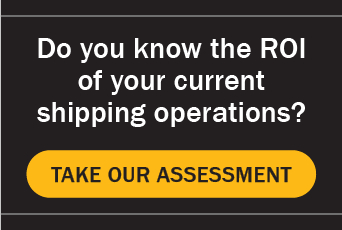A Guide to Omnichannel Supply Chain

While online shopping rose in popularity during the Covid-19 pandemic (and isn’t going anywhere), in-person shopping is still alive and well. A recent survey by PwC found that while 50% of consumers plan to increase their online spending in the near future, 50% also plan to continue going to physical stores. Your business can take advantage of consumers’ need for flexible shopping options by implementing an omnichannel supply chain.
What is omnichannel supply chain?
The supply chain is the network of people and organizations involved in creating, transporting, storing, and selling products. An omnichannel supply chain integrates multiple sales channels—such as brick-and-mortar stores, online stores, and mobile apps—to allow data and goods to flow between them easily. Omnichannel strategies create consistent, personalized shopping experiences by synchronizing inventory, customer data, and pricing across all touchpoints.
What is an omnichannel supply chain strategy?
Omnichannel supply chain strategies are focused on the customer’s experience. According to McKinsey, they “[meet] customer needs across all channels and [ground] all decisions in deep understanding of the consumer.” A consumer-centric omnichannel supply chain strategy involves these elements:
- Unified inventory management. Inventory is synced across physical and digital channels in real time. This allows customers to view and purchase products in multiple ways, seeing exactly what’s in stock at any given time.
- Consistent pricing. Nobody wants to buy something in the store, only to find out that it’s less expensive online. Pricing products consistently across all channels builds customer trust and eliminates confusion.
- Cross-channel fulfillment. An omnichannel supply chain optimizes order fulfillment by offering flexible fulfillment options such as buy online, pick up in-store (BOPIS) or ship-from-store.
- Personalization. Every consumer has their own shopping preferences—they discover and buy products in different ways. You can figure out what offers and ads will appeal most to individual consumers by sharing data across channels. This allows you to create personalized customer experiences
- Efficient order management. Centralized order management prevents overselling, reduces fulfillment errors, and speeds up order processing.
- Flexible returns. Omnichannel supply chain strategies let customers return products bought online to physical stores and vice versa. This simplicity helps boost customer satisfaction.
People have come to expect the convenience and flexibility of an omnichannel approach. By adopting an omnichannel supply chain strategy, you’ll position your business to attract and retain more customers.
What are the advantages of omnichannel in the supply chain?
While implementing an omnichannel retail supply chain strategy isn’t easy, it’s the ecommerce trend that’s here to stay. And it makes sense when you consider all the benefits. Here’s a breakdown of how adopting an omnichannel approach can fuel your business’s success.
- Enhanced customer experience. While online shopping is popular, many people still enjoy shopping in person. And sellers know this; one study reveals that 37% of businesses are planning to add ecommerce channels, and 30% plan to add brick-and-mortar channels. An omnichannel supply chain allows customers to research, buy, and return products through their preferred channel without running into obstacles.
- Increased customer loyalty. When shoppers have a great buying experience, they’re more likely to return. With a loyal base of repeat customers, your business will have a source of steady revenue.
- More efficient order fulfillment. When inventory is synced across channels, you’re able to fulfill orders more quickly and easily. Many businesses fulfill online orders using stock from brick-and-mortar stores, reducing shipping times and costs. For example, in the first quarter of 2023, Target fulfilled 80% of online orders through retail locations.
- Data-driven insights. How do your customers prefer to shop? What do they buy? How many touchpoints does it take before they complete a purchase? Using an omnichannel strategy, you can collect the data to answer these questions and more. This helps you refine your marketing to attract and retain customers.
Nothing in life comes free, and an omnichannel supply chain is no different. In addition to these benefits, an omnichannel approach also brings challenges. Let’s examine just a few.
What are the challenges of an omnichannel supply chain?
Handled well, an omnichannel supply chain boosts your operational efficiency. But if you’re not properly prepared, this strategy can be difficult to execute. As products move between brick-and-mortars, distribution centers, and customers, things get complicated. The following obstacles are what make the omnichannel approach so challenging.
- Data accuracy and consistency. To thrive with omnichannel, you must have robust data management solutions. Without them, you’ll find it nearly impossible to maintain consistent product information, pricing, and inventory data across all channels.
- Inventory visibility. Inventory visibility is one of the defining features of an omnichannel supply chain—but it’s not easy to achieve, especially when you’re dealing with high order volumes and fast-moving products.
- Complex order fulfillment. Businesses that adopt an omnichannel strategy have to figure out how to manage cross-channel fulfillment while keeping shipping costs and delivery times low.
- Supply chain disruptions. Disruptions anywhere along the supply chain can throw a wrench in omnichannel operations. And disruptions are on the rise, with 56% of retailers reporting that they happen more frequently since the Covid-19 pandemic.
- Costly implementation. To get started with omnichannel fulfillment and distribution, you need to invest in the right technology, infrastructure, and workers. Technology poses an especially difficult problem, as you’ll need to seamlessly integrate all your software systems and platforms. Thirty-five percent of businesses report a lack of time and resources as the biggest challenge to implementing an omnichannel supply chain.
These difficulties are daunting, but they present an opportunity for growth. Just make sure to do your research, consult with experts if you’re unsure what approach to take, and tackle the problem head-on. The following strategies can help you get started.
Strategies to improve your omnichannel supply chain
Managing an omnichannel supply chain requires a firm foundation of technology and infrastructure. Using these six strategies, you can set your business up for success in omnichannel.
Find the right technology
As you develop your omnichannel approach, make sure you start with the right tools.
- Enterprise resource planning system (ERP). Businesses use an ERP to manage processes like accounting, project management, supply chain operations, and more. You should choose an ERP that supports omnichannel operations and offers real-time data synchronization and reporting across all touchpoints.
- Warehouse management system (WMS). A WMS optimizes warehouse operations including storage, order picking, packing, and shipping. Using a WMS will help you save time, process orders more efficiently, and ultimately meet customers’ delivery expectations.
- Order management system (OMS). An OMS helps businesses manage orders seamlessly across channels. By centralizing order data, an OMS allows for faster processing, real-time inventory visibility, and efficient order routing.
Other valuable omnichannel tools include customer relationship management (CRM) software, which helps manage and track customer interactions and data, and point of sale (POS) systems, which facilitate sales transactions in physical stores.
Integrate inventory across channels (and make it visible)
Omnichannel supply chains must synchronize inventory information across all online and offline channels. Gathering this data into a central location provides full visibility into what inventory you have, when to reorder stock, and where to store it.
Visibility is key in striking the right balance between inventory levels and customer demand—but it can be tricky. In fact, inventory visibility is a major concern for omnichannel businesses, with 46.8% citing it as something they’d like to improve.
Fortunately, the right inventory management system will handle inventory integration for you. These systems track and control inventory levels, providing real-time visibility into the quantity, location, and movement of stock.
Optimize inventory location
When you store inventory close to customers, delivery times and costs go down. Inventory management systems help you decide where to locate inventory to best meet customer demand. When orders come in, the system ensures that products are picked, packed, and shipped from the optimal location.
As your business expands into new regions, optimizing inventory location will fuel growth and lead to increased customer satisfaction.
Use a shipping system
With shipping costs high, and rising every day, most omnichannel businesses turn to shipping software like EasyPost Enterprise. These systems connect with major and local carriers, shopping for the best rates and delivery times and allowing you to print shipping labels automatically. They can also facilitate the returns process, shipment tracking, and route optimization. The result? Money saved for you and a great delivery experience for your customers.
Develop an omnichannel returns management system
Omnichannel returns are a customer’s best friend. With so many options for returning unwanted products—in-store, curbside, home pickup, and more—customers get the flexibility and convenience they crave. For businesses, though, it’s another story. With products flowing between channels in both directions, you could face major logistical challenges.
To prevent lost items and other errors during the returns process, you should create well-defined returns policies and procedures. These should be consistent across all channels, with standard return window dates, return labels, and customer communication.
Train your employees to handle omnichannel fulfillment
Fifty-seven percent of businesses report that hiring and retaining qualified workers is one of their top supply chain challenges. But without staff members who stick around—and know what they’re doing—your omnichannel strategy won’t gain much momentum.
You can help employees become more qualified (and boost retention at the same time) by training them to handle omnichannel fulfillment. Start by defining the vision and high-level strategy of the approach, then get specific. For every employee—warehouse workers, cashiers, and customer service representatives alike—the training should help them become more customer-centric.
In addition to structured training sessions, foster a culture of continuous learning by encouraging employees to pay attention to evolving customer preferences and new technologies.
What is the difference between a multichannel and an omnichannel supply chain?
If you’ve heard the term multichannel, you’re probably wondering how multichannel and omnichannel strategies are different. Simply put, an omnichannel supply chain integrates sales channels, while a multichannel approach keeps them separate.
Omnichannel supply chains give consumers a consistent shopping experience no matter which channels they use. It works by allowing data and products to move between customers, online stores, mobile apps, physical stores, and other channels. For example, someone might buy something online and return it in-store, have an order delivered to their home, or go to the store in person to shop.
Like an omnichannel supply chain, a multichannel supply chain uses multiple channels: website, mobile app, physical store, etc. But in a multichannel model, these channels aren’t connected. Each one works in isolation, with its own inventory, pricing, and customer data. This means that BOPIS (buy online, pickup in-store) and other omnichannel offerings aren’t possible through a multichannel supply chain.
Omnichannel supply chain examples
Now let’s take a look at an omnichannel strategy in real life. These three well-known brands have perfected the omnichannel approach to give their customers immersive shopping experiences.
- Nike. Propelled by the belief that “omnichannel shoppers are ‘at least twice’ as valuable as purely online shoppers,” Nike integrates their online store and app with their own physical stores and third-party retailers. Customers can purchase products online, customize designs, and earn exclusive loyalty benefits.
- Walmart. It’s the one product that’s always in demand: food. And Walmart’s omnichannel supply chain strategy gives customers flexible ways to buy their groceries. They allow customers to order online and pick up in-store, they offer same-day delivery, and they integrate their physical and ecommerce stores. It’s no wonder that “Walmart is leading the omnichannel charge.”
- Best Buy. Not only can Best Buy customers buy online and pick their purchases up from the store, but they can also access expert advice both online and in person. The retailer’s expansion into omnichannel has been successful, with 84% of their customers using digital channels during their shopping journey.
Build Your Omnichannel Supply Chain With EasyPost Enterprise
While managing an omnichannel supply chain is challenging, it will help your business get ahead—as long as all the pieces fit in place. And shipping is one of the most critical pieces, with almost half of omnichannel consumers shopping somewhere else if delivery times are too long. EasyPost Enterprise can take your omnichannel strategy to the next level by ensuring that delivery is fast and affordable for every order.





